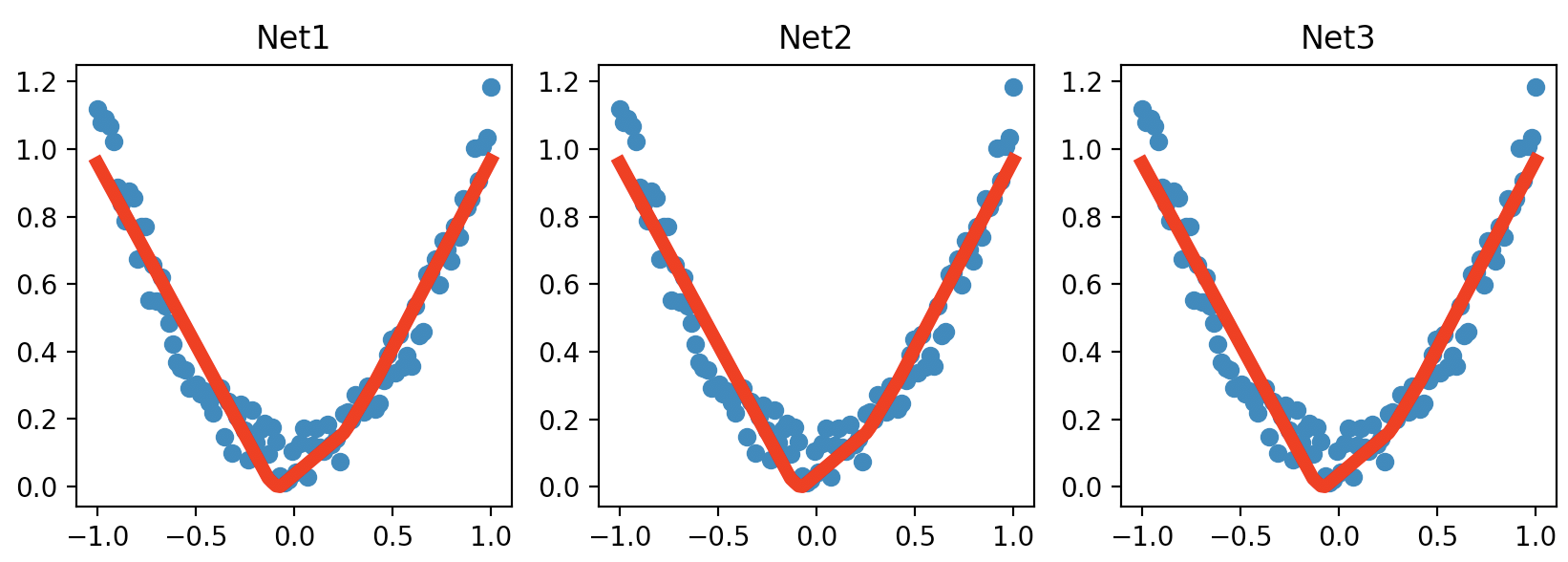保存和加载模型
在PyTorch中使用torch.save来保存模型的结构和参数,有两种保存方式:
# 方式一:保存模型的结构信息和参数信息 torch.save(model, './model.pth') # 方式二:仅保存模型的参数信息 torch.save(model.state_dict(), './model_state.pth')
相应的,有两种加载模型的方式:
# 方式一:加载完整的模型结构和参数信息,在网络较大时加载时间比较长,同时存储空间也比较大
model1= torch.load('model.pth')
# 方式二:需先搭建网络模型model2,然后通过下面的语句加载参数
model2.load_state_dic(torch.load('model_state.pth'))
注:用以上的方法保存模型时,可能会遇到UserWarning: Couldn't retrieve source code for container of type Net. It won't be checked for correctness upon loading."type " + obj.__name__ + ". It won't be checked ",可参考这篇知乎文章解决这类警告。
示例
例子来自莫烦Python
import torch
import matplotlib.pyplot as plt
# fake data
x = torch.unsqueeze(torch.linspace(-1, 1, 100), dim=1) # x data (tensor), shape=(100, 1)
y = x.pow(2) + 0.2*torch.rand(x.size()) # noisy y data (tensor), shape=(100, 1)
def save():
# save net1
net1 = torch.nn.Sequential(
torch.nn.Linear(1, 10),
torch.nn.ReLU(),
torch.nn.Linear(10, 1)
)
optimizer = torch.optim.SGD(net1.parameters(), lr=0.3)
loss_func = torch.nn.MSELoss()
for t in range(100):
prediction = net1(x)
loss = loss_func(prediction, y)
optimizer.zero_grad()
loss.backward()
optimizer.step()
# plot result
plt.figure(1, figsize=(10, 3))
plt.subplot(131)
plt.title('Net1')
plt.scatter(x.data.numpy(), y.data.numpy())
plt.plot(x.data.numpy(), prediction.data.numpy(), 'r-', lw=5)
# 2 ways to save the net
torch.save(net1, 'net.pkl') # save entire net
torch.save(net1.state_dict(), 'net_params.pkl') # save only the parameters
def restore_net():
# restore entire net1 to net2
net2 = torch.load('net.pkl')
prediction = net2(x)
# plot result
plt.subplot(132)
plt.title('Net2')
plt.scatter(x.data.numpy(), y.data.numpy())
plt.plot(x.data.numpy(), prediction.data.numpy(), 'r-', lw=5)
def restore_params():
# restore only the parameters in net1 to net3
net3 = torch.nn.Sequential(
torch.nn.Linear(1, 10),
torch.nn.ReLU(),
torch.nn.Linear(10, 1)
)
# copy net1's parameters into net3
net3.load_state_dict(torch.load('net_params.pkl'))
prediction = net3(x)
# plot result
plt.subplot(133)
plt.title('Net3')
plt.scatter(x.data.numpy(), y.data.numpy())
plt.plot(x.data.numpy(), prediction.data.numpy(), 'r-', lw=5)
plt.show()
# save net1
save()
# restore entire net (may slow)
restore_net()
# restore only the net parameters
restore_params()
运行结果:
